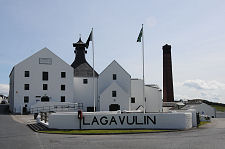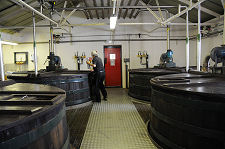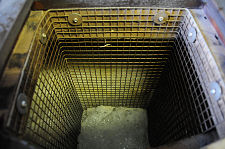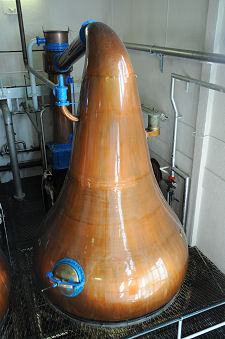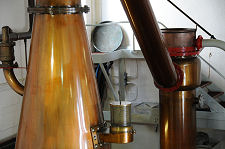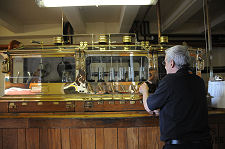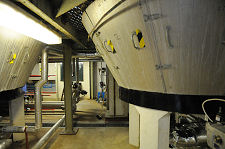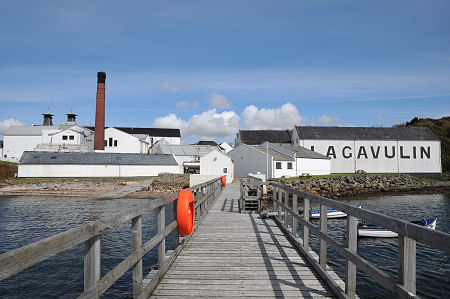 Lagavulin Distillery from the Pier |
Lagavulin Distillery is one of three distilleries that operate along the three miles of south facing coastline immediately to the east of Port Ellen on Islay. It is the second you reach (after Laphroaig) if heading east from Port Ellen, and it is the most visually arresting of the three as you approach, mainly because it stands immediately beside the main road from the village. All three are superbly photogenic, but as Lagavulin can be seen to superb effect from the visitor car park to the west, from the pier which projects out into Lagavulin Bay to the south, or from the headland to the east, it is arguably the prettiest.
Lagavulin is part of the Diageo stable of Scotch whisky distilleries and long featured as one of their six "Classic Malts", representing the Islay style of peaty, smoky, salty and powerful whiskies. The range of Classic Malts has expanded in recent years, but as a result of its promotion by Diageo over a period of more than three decades, Lagavulin is one of the best known of Islay's distilleries, and for many has come to epitomise the Islay style of whisky.
Visitors to Lagavulin park in the car park next to the road at the west end of the site and progress from there to the distillery reception accessed via a door in the old maltings facing you. The reception area and adjoining shop have a lovely welcoming feel that succeeds in giving the impression they haven't changed in many decades.
Visitors to Lagavulin Distillery are able to view most of the stages in the production process. The distillery's own floor maltings were closed in 1974, and since then it has brought in malted barley from Diageo's Port Ellen maltings a couple of miles away. Despite this, the distillery maintains a simulated fire in a peat furnace it has kept for the purpose, and as a result of this and of other artefacts like a malting chariot once used to spread the barley across the floor of the maltings, visitors do emerge with slightly more idea of the processes which have been absent from Lagavulin for nearly 40 years: and from the majority of other distilleries for a similar period.
The first stage in the process you see is the malt mill, made by Porteus of Leeds. The mash tun is a large stainless steel vessel with a stainless steel lid, complete with glass hatch through which is is possible to observe the process going on within. You can find out more about Making Malt Whisky from our series of feature pages showing the stages in the process. There are ten washbacks in all, made of larch from New England and of a considerable age. The washbacks are unusual in that when a hatch in the lid is slid back, you find yourself peering down into a square mesh tube which extends down into the vessel. This is intended to allow the state of the fermentation to be monitored and samples taken without risking the contents bubbling and splashing out during the most active phase.
There are two pairs of stills in the still room at Lagavulin, together with their condensers. The wash stills have lyne arms which descend very steeply from sharp bends at the top of the swan necks. This is an arrangement said to contribute to the unique character of Lagavulin. The spirit stills are much dumpier than the wash stills and very pear shaped with a very broad tapering neck leading to a relatively low swan neck and lyne arm. The spirit safe is on the same level as the base of the stills.
The standard distillery tour does not take in the bonded warehouse, though it is possible to book an enhanced tour that includes all the other aspects of the distillery, plus a warehouse demonstration by Lagavulin's warehouseman. En route to the warehouse you will probably notice attached to an exterior wall of the distillery a large gravestone. This was produced as a memorial to local man, Angus Johnston, after his death in 1836. He chose to be buried near the disused chapel on the offshore island of Texa. The burial went well but when the gravestone was later being loaded at Lagavulin for its passage to Texa it was dropped into the water, and superstition led to its being left where it had fallen. It was later retrieved and placed where you see it today.
The origins of Lagavulin Distillery are a little shrouded in the mists of time. Some accounts will tell you that the first of two distilleries on the site was established by John Johnston in 1816, with the second being set up by Archibald Campbell the following year. Writing in the late 1880s, however, Alfred Barnard talked of no fewer than ten small "smuggling bothies" occupying the site as early as 1742 for the production of "moonlight" or illicit whisky.
Whatever the precise sequence of events, by 1825 the two distilleries at Lagavulin were under the ownership of the Johnston family, and by 1837 the two had been rationalised into a single distillery. Further changes of ownership and management followed through the rest of the 1800s, and by the 1920s Lagavulin was owned by White Horse Distillers Ltd. Several amalgamations and takeovers later and Lagavulin Distillery became part of what is now Diageo.
Although Lagavulin Distillery today dominates Lagavulin Bay, it is not the first important structure to be build here. Very obvious in seaward views from the distillery are the remains of Dunyvaig Castle, standing on top of an outcrop of rock projecting into the east side of the bay. This was a fortress of the MacDonald Lords of the Isles, who maintained a naval base in the shelter of Lagavulin Bay, before James IV asserted his authority in 1493. In later life it was besieged and captured in 1612, 1615 and (twice) in 1647. It was largely demolished by the Campbell lairds of Islay when they moved to more modern accommodation in Islay House in 1677.
Today the castle ruins can be accessed from the headland to the east of the distillery, which is also the place you need to be in order to capture the classic view of Lagavulin, see image above left.
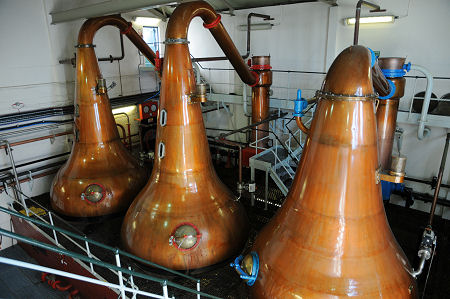 The Still Room, Showing the Two Wash Stills and One of the Spirit Stills |

|
|
|
Visitor InformationView Location on MapSTB 4 Star Visitor Attraction. Port Ellen, Isle of Islay, PA42 7DZ. Tel: 01496 302749. Grid Ref: NR 405 457 Distillery Web Page Opening Hours Tours & Admission What3Words Location: ///dilute.organist.clues |
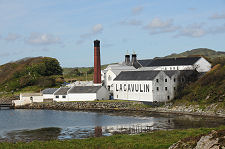 The Classic View of Lagavulin Distillery |
 The Water Supply The Water Supply |
 Dunyvaig Castle Dunyvaig Castle |
 Visitor Reception and
Shop Visitor Reception and
Shop |
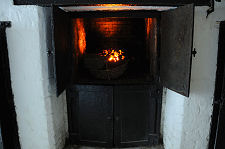 Simulated Peat Furnace
under Kiln Simulated Peat Furnace
under Kiln |
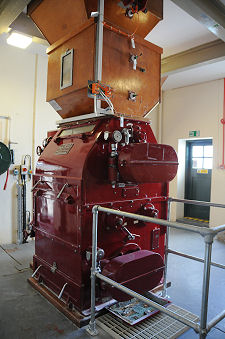 Porteus Mill Porteus Mill |
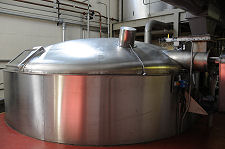 The Mash Tun |
